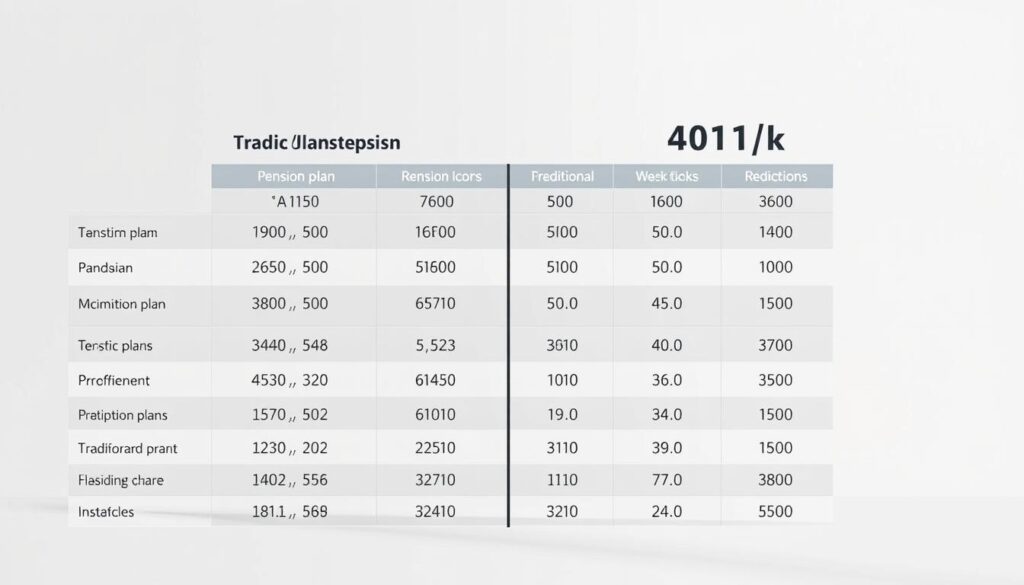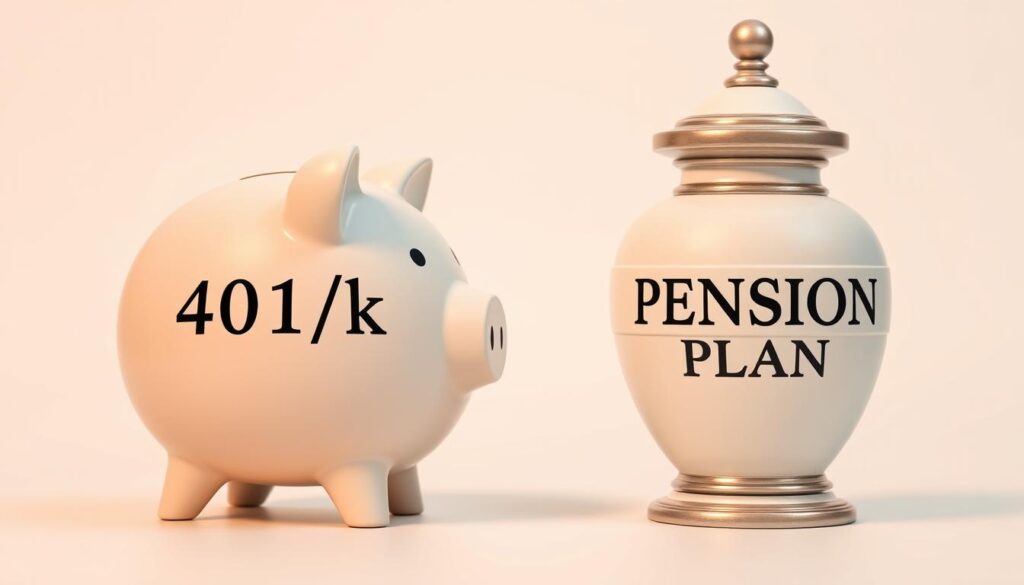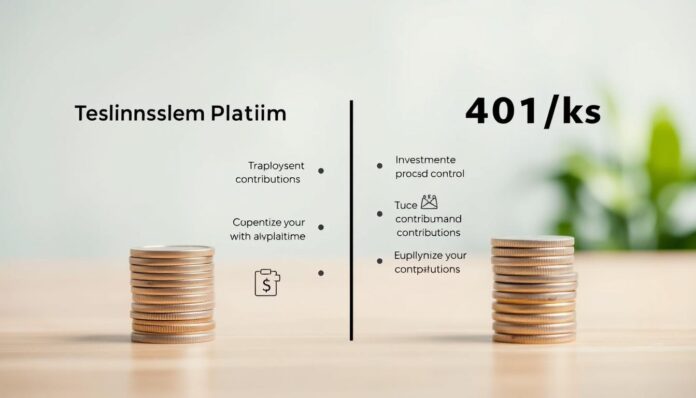Retirement planning in America has shifted dramatically over decades. Once common, traditional pensions now contrast sharply with modern 401(k) plans. This article breaks down Pension Vs 401k to help you navigate your financial future. While pensions promised steady payouts, 401(k)s put investment choices in your hands. Understanding these options is key to building stable savings.
Key Takeaways
- Pensions offer guaranteed income but are rare today
- 401(k)s let workers invest directly but require personal management
- Employer roles differ sharply between both systems
- Risk levels vary between fixed pensions and stock-based 401(k)s
- Long-term retirement success depends on choosing the right mix
Understanding Pensions: The Basics
Pensions are employer-sponsored plans designed to ensure steady income during retirement. These structured programs play a vital role in retirement planning, offering predictable payouts tied to your career. While less common in private sectors now, they remain a staple in government and public jobs.
What is a Pension Plan?
- A defined benefit plan where employers promise a specific payout at retirement.
- Payouts calculated using salary history and years of service.
- Employers typically fund the plan fully, reducing employee financial risk.
How Pensions Work
- Defined Benefit Structure: Benefits are calculated upfront, not based on investment returns.
- Vesting Periods: Employees earn permanent rights to pension benefits after meeting work requirements, often 5+ years.
- Employer-Managed Funds: Professional teams handle investments, so employees don’t need investment knowledge.
Benefits of a Pension
| Benefit | Details |
|---|---|
| Guaranteed Income | Lifetime payouts shielded from market downturns. |
| No Market Risk | Funds are professionally managed to ensure stability. |
| Easy to Use | No need to track investments—ideal for those preferring hands-off retirement planning. |
While pensions simplify retirement planning, their availability has declined. Public sector workers often still enjoy these secure pension benefits. Understanding how they work helps you evaluate their role in your long-term financial strategy.
Overview of 401(k) Plans
As retirement savings accounts evolve, 401(k) plans have become a staple in modern workplaces. These employer-sponsored accounts let workers save pre-tax income, offering 401k advantages like tax deferrals and growth potential. Let’s break down how they work.
What is a 401(k)?
A 401(k) is a retirement savings account where employees set aside part of their paycheck before taxes. Employers often match contributions, effectively giving free money to participants. For example, a common match might be 50 cents on the dollar up to 6% of salary. This creates a powerful way to build wealth over time.
Employer Contributions Explained
- Matches: Employers may add funds based on your contributions
- Vesting schedules: Some employer money locks in over years of service
- Free growth: Contributions grow tax-deferred until withdrawal
Tax Advantages of 401(k)s
401k advantages include:
| Feature | Traditional 401(k) | Roth 401(k) |
|---|---|---|
| Tax timing | Contributions deducted pre-tax | After-tax contributions grow tax-free |
| Withdrawals | Taxed as income | No taxes on withdrawals after 59½ |
Both types let earnings compound without yearly taxes, a key benefit for retirement savings accounts.
Key Differences Between Pension and 401(k)
When comparing pension vs 401k plans, three key areas stand out: funding sources, risk distribution, and mobility of benefits. This pension fund comparison clarifies how these plans work in practice.

Funding and Contributions
- Pensions: Employers fund these fully, offering set payouts without requiring employee contributions.
- 401(k)s: Workers contribute via payroll deductions, often matched by employers up to a limit.
Risk plays a major role in long-term outcomes:
Risk Factors for Employees
- Pensions: Employers manage investments, absorbing market risks so payouts stay stable.
- 401(k)s: Employees choose investments, bearing full responsibility for gains or losses.
What happens when you switch jobs?
Portability of Benefits
- Pensions: Benefits often depend on years with the same employer, making them less transferable.
- 401(k)s: Funds move with you—easily rolled over to new jobs or retirement accounts.
Investment Control: Pensions vs 401(k)s
When it comes to employer-sponsored retirement plans, who decides where your money grows? The answer shapes your role in retirement planning. Pensions and 401(k)s take opposite approaches to investment control.
Who Manages Pension Investments?
Pension funds are professionally managed by the employer or third-party firms. Employees have no say in stock picks, bond allocations, or risk levels. This hands-off approach removes stress but limits customization. For example, public sector pensions often use union-negotiated investment committees to oversee assets.
Individual Control in 401(k) Plans
401(k)s flip control to employees. You choose from pre-selected fund options like index funds or target-date funds. Your decisions directly impact growth—good or bad. Over 60% of workers use target-date funds to simplify choices, per Vanguard data.
| Aspect | Pension Plans | 401(k) Plans |
|---|---|---|
| Investment Decisions | Employer-managed | Employee-chosen |
| Risk Management | Professional oversight | Self-directed |
| Customization | None | Variable by plan offerings |
“401(k)s turn everyone into an investor whether they want to be or not,” says retirement advisor Sarah Meyers. “That’s both opportunity and responsibility.”
While pensions shield you from market volatility decisions, 401(k)s demand proactive participation. Balancing this requires education—many employers now offer robo-advisors or financial wellness programs to bridge the gap. Your choice affects long-term outcomes, making this a critical part of retirement planning strategy.
Payment Structures: How You Get Your Money
Retirement savings accounts like pensions and 401(k)s differ in how funds are distributed. Understanding these differences helps plan your income streams effectively.
Payout Options for Pensions
Pension benefits typically offer steady income streams:
- Monthly payments: Fixed amounts paid for life, often adjusted for inflation.
- Joint and survivor options: Continue payments to a spouse after death.
- Lump-sum payouts: A one-time cash option, though tax impacts may reduce net gains.
Withdrawal Options for 401(k)s
Retirement savings accounts like 401(k)s provide flexible withdrawal methods:
Key strategies include:
- Required minimum distributions (RMDs): Mandatory withdrawals start at age 73, avoiding penalties.
- Systematic withdrawals: Tailor monthly amounts to match lifestyle expenses.
- Annuity conversions: Transform savings into lifelong payments, mimicking pension benefits.
| Option | Pension Benefits | 401(k) Options |
|---|---|---|
| Guaranteed Income | Yes (monthly) | No, but annuities can replicate this |
| Flexibility | Limited to plan terms | High—adjust withdrawals yearly |
| Risk Exposure | Low (employer-backed) | High (market-dependent) |
Choosing between these structures depends on goals. Those seeking stability may prefer pension benefits, while investors valuing control might favor 401(k) flexibility. Visit this guide to explore maximizing retirement savings accounts further.
The Role of Employers in Retirement Plans
Employers shape retirement outcomes through the types of employer-sponsored retirement plans they offer. Let’s explore how obligations differ between pensions and 401(k)s—and why this matters for your savings strategy.
Employer Obligations for Pensions
Pensions require employers to fully fund and manage retirement benefits. Under ERISA laws, companies must guarantee payouts, even during financial struggles. This long-term responsibility has pushed 80% of businesses to abandon pensions, prioritizing simpler employer-sponsored retirement plans like 401(k)s.
Employer Support for 401(k) Participation
With 401(k)s, employers act as enablers, not guarantors. Many offer matching contributions—like adding 3% for every dollar you save—to boost savings. While pension vs 401k contributions differ sharply—pensions promise fixed payouts, 401(k)s rely on employee choices—both require smart employee decisions. Employers may provide educational tools or plan options to help you grow your nest egg.
Flexibility and Customization
Pension plans offer fixed benefits calculated using formulas based on salary and service years. This structure provides stability but limits personal adjustments. In contrast, 401k advantages shine in customization. With a 401(k), you choose how much to contribute, where to invest, and how to withdraw funds—tailoring retirement planning to your life’s unique path.
Pension Plans: Fixed Benefits
Traditional pensions follow strict rules. Once vested, your payout depends on company formulas—no room to adapt to changing goals or market shifts. This suits those who prefer predictable outcomes over active management.
401(k) Plans: Personal Investment Choices
401(k)s let you pick from stocks, bonds, and funds. Adjust contributions anytime, and rebalance portfolios to match evolving risk tolerance. This flexibility supports retirement planning that adapts to life events like career changes or family needs.
| Aspect | Pension Plans | 401(k) Plans |
|---|---|---|
| Contribution Control | Employer-managed | Employee chooses contribution % |
| Investment Options | None—funds managed by employer | Dozens of investment options |
| Withdrawal Flexibility | Set payout schedule | Custom withdrawal timing |
“The best retirement plans align with your lifestyle, not just your paycheck.” — Financial Planning Association
Choosing between these options depends on personal preferences. If you value hands-on control, 401(k) flexibility helps shape a retirement planning strategy that grows with you. Those seeking steady, no-hassle income may favor pensions. Either way, understanding these differences empowers smarter decisions.
Retirement Security and Stability
Choosing between pensions and 401(k)s means weighing security against flexibility. Pension fund comparison shows guaranteed payouts, but their stability hinges on the fund’s health. Retirement savings accounts like 401(k)s offer control but come with market risks. Let’s explore how these options handle uncertainty over time.
Pension Funds: Guaranteed Benefits, Hidden Risks
Pensions promise lifelong payments, backed by employer and government safeguards. The Pension Benefit Guaranty Corporation (PBGC) protects some benefits if a plan fails, but payouts are capped. Pension fund comparison reveals that underfunded plans may face cuts during economic downturns, leaving retirees exposed.
401(k) Volatility: Riding the Market’s Ups and Downs
Retirement savings accounts like 401(k)s let you invest, but market swings can shrink balances. Near retirement, a bad year’s returns—sequence-of-returns risk—might force early withdrawals. Strategies like shifting to bonds or cash as you age can reduce exposure. Meanwhile, fixed pension payouts may lose value to inflation over decades.
“Retirement savings accounts thrive when plans adapt to time horizons and risks.”
Both paths require balancing guarantees with growth. Pensions shield against market drops but face inflation threats. 401(k)s demand active management to avoid timing pitfalls. The key? Tailor your strategy to your comfort with risk and long-term goals.
Making the Choice: Which is Right for You?

Retirement planning requires matching your situation to the right option. Start by weighing these elements:
Factors to Consider
Ask yourself these questions before deciding:
- Do you prefer guaranteed income or hands-on investing?
- Is your job likely to stay stable long-term?
- Are you comfortable managing investments?
| Factor | Pension | 401(k) |
|---|---|---|
| Income Certainty | Fixed payments | Depends on market |
| Flexibility | Set terms | Customizable |
| Risk Level | Lower personal risk | Market risk |
Your Retirement Goals
Align your priorities with the plan’s strengths:
- Guaranteed income: Pensions suit those needing stability.
- Hands-on control: 401(k)s offer investment choices.
- Legacy plans: 401(k)s allow heirs to inherit balances.
Discuss these with HR or a financial advisor to tailor your strategy. Both Pension Vs 401k options can work—choose the fit for your lifestyle and goals.
Final Thoughts: The Best of Both Worlds
Retirement planning doesn’t have to be an either/or choice between pensions and 401(k)s. Many workers today have access to employer-sponsored retirement plans, and blending strategies can strengthen financial security. Whether you rely on one or both, the right approach balances guaranteed income with growth opportunities.
Combining Pension and 401(k) Benefits
If you’re lucky enough to have both, focus on maximizing pension vs 401k contributions. Pensions provide steady income, while 401(k)s let you grow savings through investments. Aim to contribute enough to get full employer matches in your 401(k) even if you have a pension. Supplement with Roth IRAs or low-cost index funds to diversify further. Annuities could also add stability to volatile markets.
Preparing for a Secure Retirement
For those with only one option, create balance elsewhere. Pension holders might boost savings in taxable accounts or real estate. 401(k) participants should set automatic increases to contributions yearly. Review investment allocations annually to match your timeline and risk tolerance. Tools like Vanguard’s LifeTime Withdrawal Calculator or Fidelity’s Retirement Score help track progress.
Success hinges on consistency. Start by adjusting contributions to meet at least 15% of income. Talk to a fee-based advisor about tax-efficient withdrawals. Retirement security isn’t about choosing perfectly—it’s about starting now and staying disciplined. Your future self will thank you for every dollar saved wisely today.

